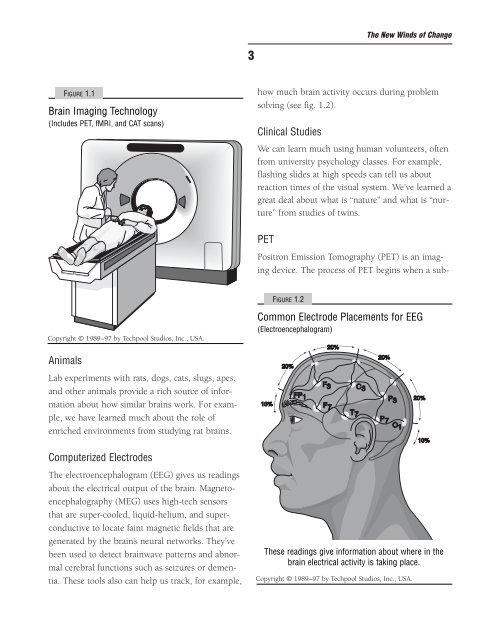You also want an ePaper? Increase the reach of your titles
YUMPU automatically turns print PDFs into web optimized ePapers that Google loves.
FIGURE 1.1<br />
<strong>Bra<strong>in</strong></strong> Imag<strong>in</strong>g Technology<br />
(Includes PET, fMRI, and CAT scans)<br />
Copyright © 1989–97 by Techpool Studios, Inc., USA.<br />
Animals<br />
Lab experiments with rats, dogs, cats, slugs, apes,<br />
and o<strong>the</strong>r animals provide a rich source of <strong>in</strong>formation<br />
about how similar bra<strong>in</strong>s work. For example,<br />
we have learned much about <strong>the</strong> role of<br />
enriched environments from study<strong>in</strong>g rat bra<strong>in</strong>s.<br />
Computerized Electrodes<br />
The electroencephalogram (EEG) gives us read<strong>in</strong>gs<br />
about <strong>the</strong> electrical output of <strong>the</strong> bra<strong>in</strong>. Magnetoencephalography<br />
(MEG) uses high-tech sensors<br />
that are super-cooled, liquid-helium, and superconductive<br />
to locate fa<strong>in</strong>t magnetic fields that are<br />
generated by <strong>the</strong> bra<strong>in</strong>’s neural networks. They’ve<br />
been used to detect bra<strong>in</strong>wave patterns and abnormal<br />
cerebral functions such as seizures or dementia.<br />
These tools also can help us track, for example,<br />
3<br />
how much bra<strong>in</strong> activity occurs dur<strong>in</strong>g problem<br />
solv<strong>in</strong>g (see fig. 1.2).<br />
Cl<strong>in</strong>ical Studies<br />
We can learn much us<strong>in</strong>g human volunteers, often<br />
from university psychology classes. For example,<br />
flash<strong>in</strong>g slides at high speeds can tell us about<br />
reaction times of <strong>the</strong> visual system. We’ve learned a<br />
great deal about what is “nature” and what is “nurture”<br />
from studies of tw<strong>in</strong>s.<br />
PET<br />
The New W<strong>in</strong>ds of Change<br />
Positron Emission Tomography (PET) is an imag<strong>in</strong>g<br />
device. The process of PET beg<strong>in</strong>s when a sub-<br />
FIGURE 1.2<br />
Common Electrode Placements for EEG<br />
(Electroencephalogram)<br />
These read<strong>in</strong>gs give <strong>in</strong>formation about where <strong>in</strong> <strong>the</strong><br />
bra<strong>in</strong> electrical activity is tak<strong>in</strong>g place.<br />
Copyright © 1989–97 by Techpool Studios, Inc., USA.



